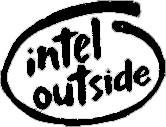Commonwealth Network
JFK's Macintosh Sushi |

|
Mac Trick, Tip or Quip of the Week
I would like to continue with some basic troubleshooting help. Last time we talked about the need to have some good tools on hand and to perform some basic maintenance that will cut down on the problems you have and give you a better chance of solving your problems more quickly when they do occur.Two of the most common troubleshooting techniques are rebuilding the desktop and zapping the PRAM.(When I was a new user and I first heard about zapping the PRAM I thought it sounded like something out of Star Trek: "Captain, the crystals are almost out of power, I've tried to zap the PRAM, but she's not responding!") Most of you are probably aware of what these two techniques are for and how to do it, but for the sake of those who don't: 1)Rebuilding the desktop: This is accomplished by holding down the command and option as the computer is starting up. At the end of the start up sequence, you will be given a dialog box which asks if you would like to rebuild the desktop, click yes and the computer will rebuild the desktop. You should do this every couple of months as part of routine system maintenance. The desktop file contains directory information and tells the finder what documents belong to which application and also contains some necessary invisible files. One sure way of knowing it is time to rebuild the desktop is if some of your documents or applications have lost their usual icons and appear as generic documents or applications. If the desktop needs rebuilding you might even be unable to launch a document by double-clicking on it. 2)Zapping the PRAM. The PRAM (Parameter RAM) is a portion of memory where some system information is stored, such as the date and time and many of the user set preferences. Your back-up battery keeps this information safe and sound even when you shut the computer down. If you start seeing strange dates appear on your computer, like 1906, you may have a dead back-up battery which will need to be replaced. The PRAM can also become corrupted. Zapping the PRAM clears the PRAM and resets the information to the default settings. After zapping the PRAM, it may be necessary to reset some of your user preferences. To zap the PRAM you hold down the keys Command-Option-P-R at start up.(This also provides good exercise for your fingers.) Now that I've told you about the traditional way to perform these two functions, let me tell you it is not the best way. There is a piece of freeware available from a company called MicroMat called TechTool which performs both of these functions and actually does it better than the traditional way. When TechTool rebuilds the desktop it will first delete the old desktop file. This is a better method, because it insures that no corruption from the old desktop file is retained. You have a brand new clean desktop file. The way TechTool zaps the PRAM is also better than the traditional method because it actually clears the PRAM completely and more deeply than the traditional method. TechTool also will do some neat things like analyze your system for you. It's one of the nicest pieces of freeware available. There is also a commercial version called Techtool Pro that has even more features and does very thorough diagnostics. You can get more info about TechTool Pro and download the current TechTool freeware from MicroMat Be sure to read the accompanying manual when using TechTool. We will continue our troubleshooting series next week. I'd like to discuss ways to go about isolating and solving problems with your system, so be sure to check back. If you have a tip you'd like to pass along, don't hesitate to send it. Previous weeks' tips are here. |


Home Theo Mac Home Page Help Webrings Mail